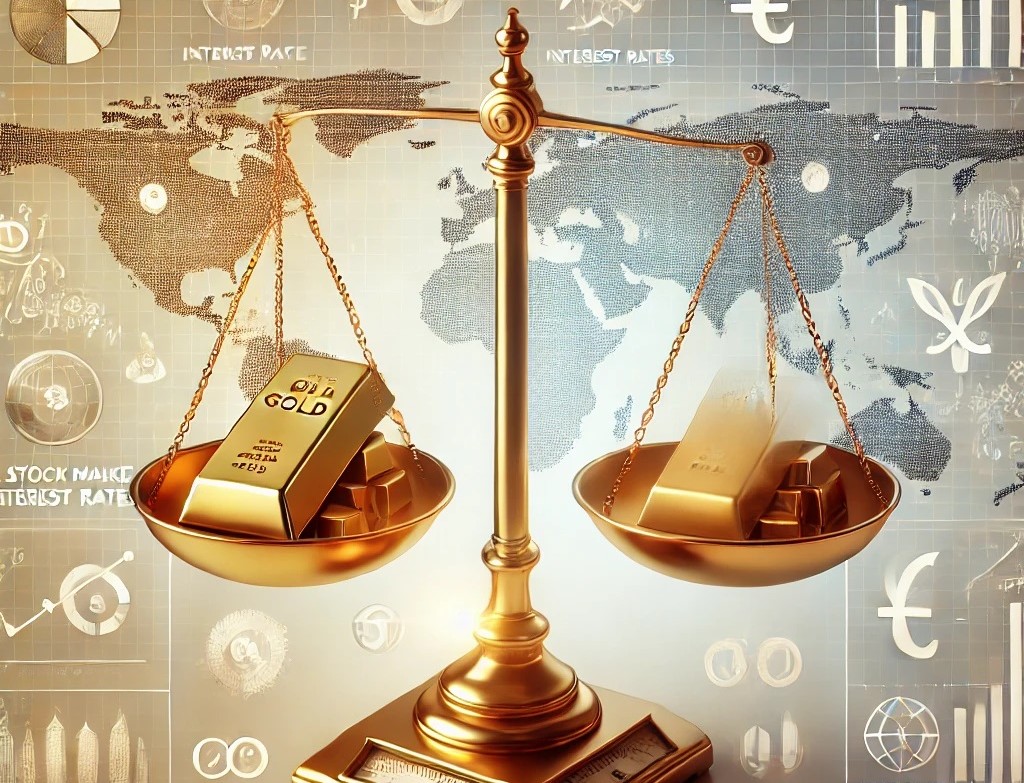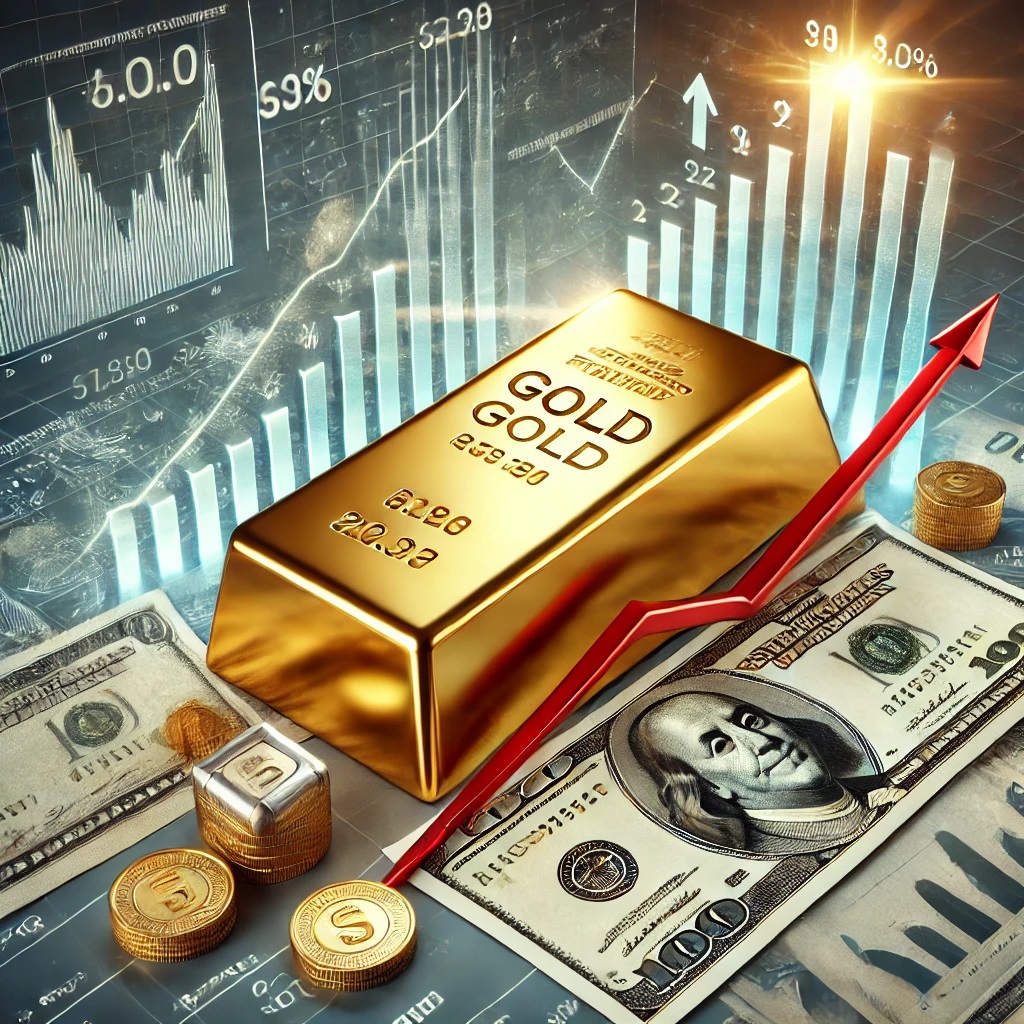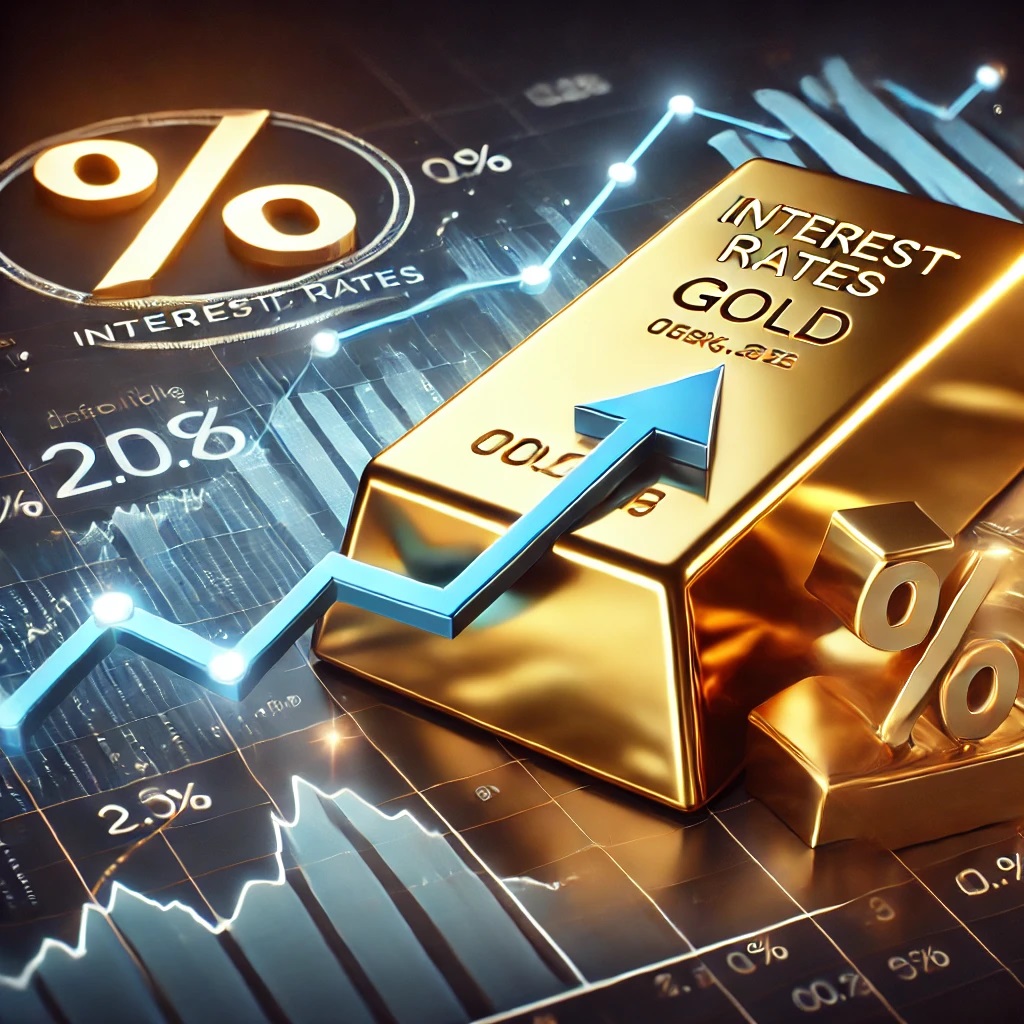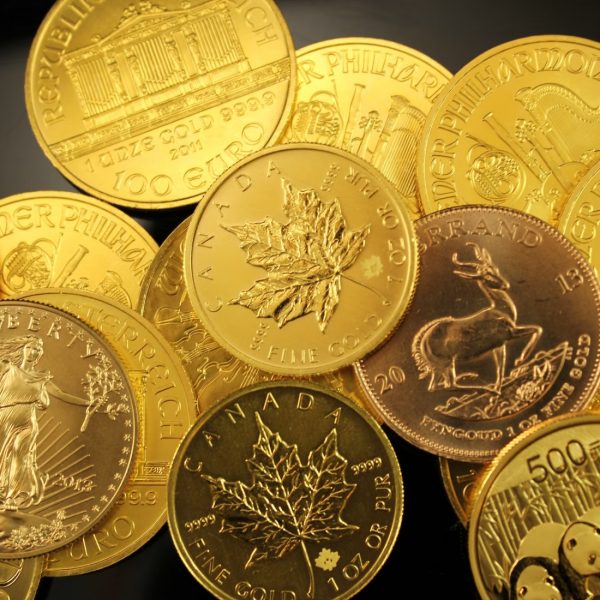What Moves Gold Prices?
01/11/2024Daniel Fisher
Free & fully insured UK Delivery. Learn more
Secure & flexible payments. Learn more

Buyback Guarantee Learn more

Investors often turn to gold for its stability, using it to hedge against inflation, diversify portfolios, and reduce exposure to market volatility.
Yet, gold prices are anything but static. While the daily Gold Price fix is set by a committee, prices are influenced by a complex mix of global economic factors, shifting supply and demand, and the ever-changing value of the U.S. dollar.
This post will break down these key drivers, covering the major factors that impact gold prices, from local currency values and central bank policies to inflation, and interest rates.
While the performance of physical gold values is famously independent from any corporation or Government, it’s certainly influenced by global currency values. In fact, the relationship between gold prices and currencies is a fundamental part of understanding why gold’s value fluctuates around the world.
While the global gold price is generally quoted in U.S. dollars (USD), currency movements in local markets can significantly impact gold prices, making it more or less expensive for consumers and investors depending on where they live.
Gold prices in any given country don’t only depend on the global market—they’re also influenced by the local currency’s strength or weakness against the U.S. dollar. If a country’s currency depreciates against the dollar, the price of gold in that local currency will increase, even if the global USD price of gold stays the same. For instance, in countries experiencing currency weakness or inflation, gold prices may rise sharply in local terms, often boosting demand as people look for stable assets.
This relationship also means that investors and consumers in countries with a strong currency can sometimes access gold at a relatively lower price compared to those in weaker-currency countries, even when the USD price of gold is steady. Ultimately, local currency fluctuations can create unique investment opportunities or challenges in different markets around the world.

The U.S. dollar plays a pivotal role in the gold market because it is the primary currency used to price gold globally. This unique positioning creates an inverse relationship between the U.S. dollar and gold: when the dollar strengthens, gold prices often decrease, and when the dollar weakens, gold prices tend to rise. Why? A strong dollar makes gold more expensive for foreign buyers, reducing demand and pushing prices down. Conversely, a weak dollar makes gold more affordable for international buyers, driving up demand and price.
The dollar’s influence on gold prices is particularly noticeable during times of economic uncertainty due to the two asset’s competing as the world’s preferred safe haven. For example, during the 2008 financial crisis, the dollar weakened significantly, and gold prices soared as investors around the world turned to gold as a safe asset. Conversely, a stronger dollar, often linked to higher U.S. interest rates, can reduce global demand for gold, leading to price drops. This inverse relationship is a central concept in the gold market and one that investors and analysts closely monitor to gauge potential price movements.
The dynamic between an asset’s supply and demand provides the overwhelming influence on its value. One of the unique attributes of physical gold is that its supply is finite – a significant contrast with fiat money which can be increased at will.
Unlike some other commodities, gold cannot be produced rapidly to meet sudden increases in demand. The availability of gold in the market depends on a steady and often slow process of mining and refining, combined with sales from gold reserves held by central banks. Let’s explore how these supply-side factors impact the price of gold.

The primary source of new gold is mining, but mining output is limited by many factors. Gold mining is capital-intensive and requires significant resources, from exploration to extraction. There hasn’t been a major new gold discovery for more than two decades, which means that extraction needs to go deeper into the earth at a higher cost. Global gold production fluctuates based on factors such as ore quality, mining regulations, geopolitical stability in mining regions, and technological advancements.
Moreover, the cost of gold production directly influences its price. If production costs rise due to increased labour or energy expenses, mining companies might reduce their output or raise prices to maintain profitability, which can impact global supply and lead to higher gold prices. Conversely, when production costs decrease or new gold reserves are discovered, the additional supply may lower prices, though this typically happens gradually. Overall, the pace and cost of gold mining are significant, underlying factors that help set the stage for gold’s long-term pricing trends.

Another major supply factor is the action of central banks, which hold substantial gold reserves as part of their national assets. Central banks can influence the gold supply by buying or selling gold in the open market. Gordon Brown famously sold the UK’s gold reserves between 1999-2002 to raise capital and diversify.
When central banks purchase gold, they effectively remove some of the available supply from the market, which can drive up prices. On the other hand, when central banks decide to sell portions of their reserves, it can increase supply and put downward pressure on prices.
For instance, in the late 1990s and early 2000s, several European central banks coordinated to sell portions of their gold reserves, which temporarily increased supply and contributed to a dip in global gold prices. In contrast, central banks in recent years, especially in emerging economies such as China and Russia, have become net buyers of gold to diversify reserves and reduce dependency on the U.S. dollar. These purchases have limited gold’s available supply, helping to support higher prices in the market.
Free ultimate guide for keen precious metals investor
The flip side to gold’s limited supply is its ever-growing demand. Gold’s demand profile is diverse, ranging from investment and reserve purposes to its use in jewellery and industrial applications. While overall demand for gold is rising, the nuances of each sector fluctuate, affecting short- and medium-term gold prices.

Gold’s role as an investment vehicle is one of the primary factors influencing its demand. Often viewed as a “safe haven” asset, gold attracts investors during times of economic uncertainty, market volatility, or geopolitical tension. When confidence in traditional investments like stocks and bonds wavers, investors turn to gold as a store of value, driving up demand—and with it, prices.
Gold investment demand manifests in different forms, including direct purchases of physical gold (bullion and coins) and indirect exposure through financial instruments like gold exchange-traded funds (ETFs). As global uncertainties ebb and flow, so does the demand for gold as an investment, making this a significant and sometimes volatile contributor to gold pricing.

Another important factor within investment demand is gold’s role in portfolio diversification. Investors seeking a balanced portfolio often include gold due to its historical tendency to perform differently than stocks, bonds, and other traditional assets. Gold typically has a low or negative correlation with other asset classes, meaning it can provide stability during market downturns. This makes it an attractive addition to diversified portfolios, helping investors to reduce overall risk and maintain value during turbulent economic times.
As a diversifier, gold is especially appealing to institutional investors, who may include it in pension funds, mutual funds, or other managed portfolios to manage risk. This demand for diversification often increases in response to economic downturns or forecasts of future volatility, further boosting gold demand and price.

In addition to holding gold as reserves, central banks around the world actively purchase gold to manage currency risks and diversify their asset holdings. This practice has become particularly prominent among emerging economies that seek to reduce reliance on the depreciating U.S. dollar, for both economic and political reasons. Central bank purchases increase the demand for gold, which can support or even elevate prices due to their significant buying-power.
For example, countries like China, Russia, and India have consistently added to their gold reserves in recent years as a means of economic security and diversification. This trend of central bank buying not only impacts global demand but also contributes to gold’s image as a stable asset for national reserves, underscoring its value as a strategic resource. If paper currencies continue to depreciate and de-stabilize, a possible return to the gold standard would spark substantial central bank buying.

Possibly the first encounter people have with gold is through jewellery. Gold’s appeal as a material for jewellery and its use in industry contribute significantly to its global demand profile.
Jewellery such as necklaces, bracelets, earrings, watches, and rings, accounts for a large share of the demand for physical gold, especially in regions like India and China, where gold is deeply ingrained in cultural traditions and celebrations. Seasonal events, festivals such as Diwali, and weddings can drive periodic spikes in gold jewellery demand, which in turn impacts prices.
Gold is used widely in various industrial applications due to its excellent conductive and corrosion-resistant properties. Its industrial demand, while smaller than its demand for jewellery or investment, is crucial for electronics, medical devices, and other high-tech sectors. Although industrial demand typically doesn’t drive prices as strongly as investment or jewellery demand, it still plays a role in the broader demand picture and helps sustain gold’s value over time.
Gold’s price movements are closely tied to broader economic conditions and market sentiment. As a versatile asset often seen as a hedge against financial instability, gold is sensitive to shifts in economic health, global tensions, and historical pricing cycles. Tracking these economic and market factors can help forecast gold prices, give a clearer view of why gold’s value fluctuates, and understand how it fits into the larger financial landscape.

Gold prices often react to changes in the global economy, serving as a barometer of financial health. During economic downturns, recessions, or financial crises, investors frequently seek gold as a “safe haven” asset. This increase in demand can drive up gold prices, as investors look to protect their wealth against declining stock markets, currency devaluations, and other risks. For example, during the 2008 financial crisis, gold prices rose sharply as investors sought security outside traditional financial assets.
Conversely, during periods of strong economic growth, investor appetite for gold may decrease as they gravitate toward assets with potentially higher returns, like equities or property. This can lead to a dip in demand and prices for gold. As such, gold often moves inversely with economic cycles, making it a valuable counterbalance for investors during times of economic stress.

Gold is also highly sensitive to geopolitical tensions. During periods of global uncertainty, such as wars, trade disputes, or political instability, demand for gold as a “safe asset” typically rises, pushing prices higher. Geopolitical events can disrupt markets and weaken investor confidence in traditional assets, leading to increased buying of gold as a protective measure.
For instance, during times of heightened tensions in the Middle East or trade conflicts between major economies, gold prices have historically seen spikes. Gold’s appeal as an apolitical, universally recognized store of value means that it remains attractive when other assets are perceived as risky due to political or military tensions. In this way, geopolitical instability acts as a strong driver of demand for gold, often leading to sudden price increases.

One of the questions we get asked most is the best time to buy gold? Gold prices have followed cyclical patterns over time, with notable peaks and troughs that often correspond to major economic or political events. Understanding these historical trends can offer valuable insights into gold’s behaviour and help investors anticipate potential price shifts based on past cycles.
For example, gold prices surged in the 1970s during periods of high inflation and again in the 2000s following the dot-com bubble and the 2008 financial crisis. These historical spikes were fuelled by economic instability, high inflation, and a flight to safe assets. Similarly, gold saw a decline in the 1980s and 1990s when economic conditions stabilized, and confidence in stocks and other investments grew.
While historical trends do not guarantee future results, they highlight gold’s unique ability to perform strongly during periods of market stress and economic upheaval. Analysts will quote the mantra “History may not repeat, but it does rhyme”.
Live Gold prices and historical charts

Inflation is one of the most significant drivers of gold prices, as gold is widely seen as a hedge against rising prices and declining currency value. When inflation rates rise, the purchasing power of money decreases, leading many investors to seek alternative assets that can retain their value over time. Gold, with its reputation as a stable store of value, becomes especially attractive during periods of high inflation.
Historically, gold has shown a tendency to perform well when inflation is on the rise. When prices increase rapidly, investors often buy gold to protect against the devaluation of cash and other financial assets. This increased demand can push gold prices higher, as more investors turn to it as a safeguard against the erosion of purchasing power. A famous analogy provides a reminder of gold’s enduring value. It says that a good quality suit would have cost around £20 in the 1930s, similar to an ounce of gold at the time. While an ounce of gold now (being over £2,000) would still buy a fantastic suit, your £20 would struggle to afford a tie.
The relationship between inflation and gold prices also works in reverse; during periods of low or stable inflation, the demand for gold as an inflation hedge tends to diminish, which can lead to weaker price growth or even declines. For instance, when inflation remains low and economic conditions are stable, other investments, such as stocks or bonds, may appear more appealing, reducing the relative demand for gold.
Inflation expectations also play a role. If investors anticipate future inflation due to factors like rising energy costs, government spending, or supply chain disruptions, they may begin buying gold in advance. This speculative buying can cause gold prices to rise, even if inflation has not yet materialized.

Interest rates have a complex and influential relationship with gold prices. While they don’t directly determine gold’s value, interest rates impact the demand for gold by shaping its appeal relative to other investments. Generally, gold tends to have an inverse relationship with interest rates: when interest rates rise, gold prices often fall, and when rates decline, gold prices tend to rise.
This inverse relationship exists because gold is a non-yielding asset, meaning it doesn’t provide interest or dividends like bonds or savings accounts do. When interest rates are high, assets like US Treasuries and other fixed-income securities become more attractive to investors because they offer a regular return. Consequently, the opportunity cost of holding gold (which has no yield) increases, leading to lower demand and downward pressure on prices. Some prefer to leave money in the bank to yield the relatively good interest rates.
On the flip side, when interest rates are low or declining, the returns on interest-bearing assets fall, reducing the opportunity cost of holding gold. This makes gold more appealing as a safe-haven asset, especially in uncertain economic conditions or when inflation is a concern. Additionally, low interest rates often coincide with efforts to stimulate economic growth, which can weaken currencies and drive investors toward gold as a store of value.
Real interest rates—interest rates adjusted for inflation—are particularly important in the gold market. When real interest rates are negative (i.e., inflation is higher than nominal interest rates), the demand for gold often rises because cash and bonds lose purchasing power in real terms. Negative real rates make gold more attractive as an asset that can hold value even when other investments fail to keep pace with inflation.


Gold prices are controlled by a mix of supply and demand, the strength of the U.S. dollar, global inflation, interest rates, and economic policies. Investment demand, central bank reserves, and geopolitical tensions also drive price fluctuations, making gold a dynamic asset sensitive to both economic conditions and market sentiment.
Gold prices drop when supply exceeds demand, investor interest wanes, or economic conditions favour other assets. A strong U.S. dollar, rising interest rates, and low inflation reduce gold’s appeal, leading to price declines as investors shift to yield-bearing alternatives.
Gold prices increase due to rising demand from investors and central banks, economic uncertainty, inflation, and a weakening U.S. dollar. Limited supply from mining, coupled with gold’s appeal as a safe-haven asset during market volatility, also drives prices higher as investors seek stability.
The price of gold is set by global market forces, primarily through supply and demand dynamics in the commodities markets. Influences include investor demand, central bank policies, currency strength, and economic conditions. Additionally, twice daily, the London Bullion Market Association (LBMA) sets a benchmark price used as a reference worldwide.
To predict gold prices, analyse economic indicators like inflation, interest rates, and currency strength, especially the U.S. dollar. Monitor supply-demand trends, central bank policies, and geopolitical events, as these factors influence gold’s appeal as a safe-haven asset. Market sentiment and historical price cycles can also offer insights into future price movements.
Live Gold Spot Price in Sterling. Gold is one of the densest of all metals. It is a good conductor of heat and electricity. It is also soft and the most malleable and ductile of the elements; an ounce (31.1 grams; gold is weighed in troy ounces) can be beaten out to 187 square feet (about 17 square metres) in extremely thin sheets called gold leaf.
Live Silver Spot Price in Sterling. Silver (Ag), chemical element, a white lustrous metal valued for its decorative beauty and electrical conductivity. Silver is located in Group 11 (Ib) and Period 5 of the periodic table, between copper (Period 4) and gold (Period 6), and its physical and chemical properties are intermediate between those two metals.